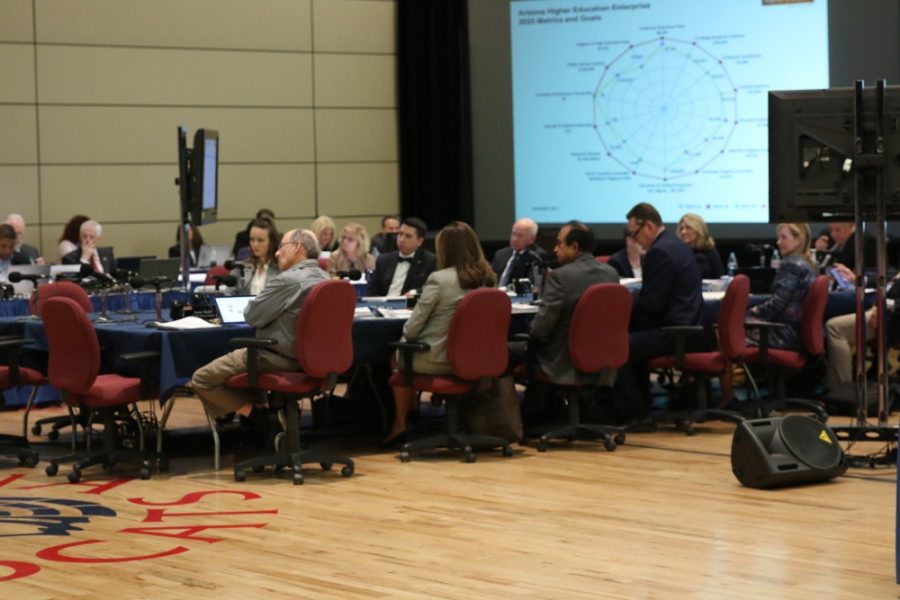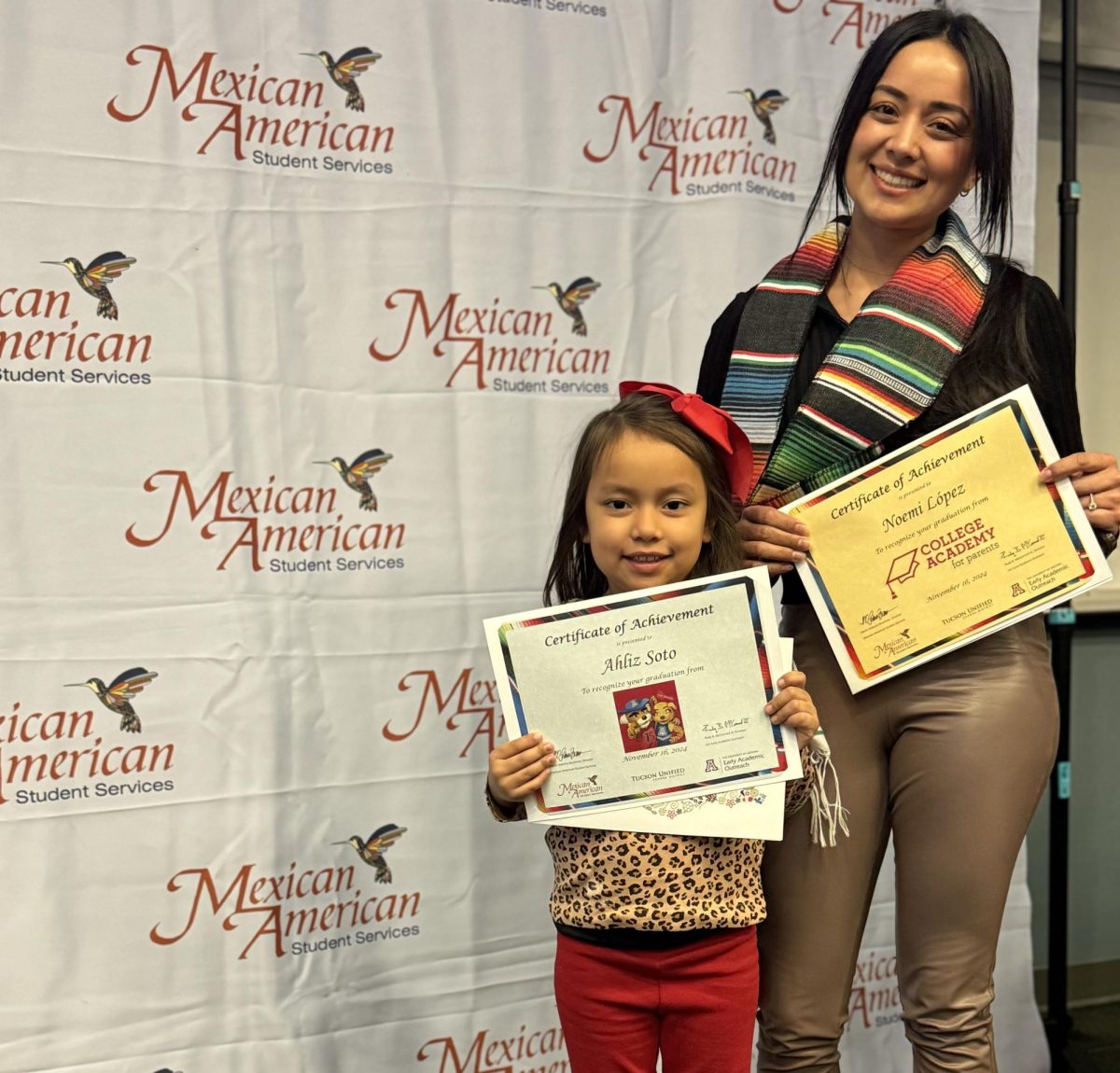At their semi-annual meeting on the University of Arizona campus, the Arizona Board of Regents discussed monetary concerns, such as the leasing of university property for commercial use and data on student debt and graduate wages.
The Arizona Board of Regents governs Arizona’s three public universities, UA, Arizona State University and Northern Arizona University.
Messages from UA President Robbins and ASUA President Masters
As the president of the university where the regents held their meeting, President Dr. Robert Robbins was able to address the board at the start of Thursday’s session.
In addition to welcoming the regents to campus, Robbins touched on the UA men’s basketball team’s victory the night before as well as OSIRIS-REx’s upcoming arrival at its target asteroid Bennu.
He also spoke on former UA president Henry Koffler, who died earlier this year. “I was lucky to have known him for a short time,” Robbins said about Koffler.
During the call to the audience portion of the meeting, Associated Students of the University of Arizona Student Body President Natalynn Masters addressed the regents.
In her brief speech, Masters highlighted the Campus Pantry program and the ASUA SafeRide program as “amazing” resources for students.
She also expressed her desire to continue working with the administration to establish more transparency and expand support for students.
“One of the things we’re really working on this year is trying to include that transparency in the work that we’re doing … working with the administration, working with Dr. Robbins to do transparency and diversity work,” Masters said.
Commercial leasing of university properties
At the meeting, board Chief Financial Officer Lorenzo Martinez presented the first reading of proposed revisions to the board’s policies on leasing university properties for commercial purposes.
Components of the plan include guidelines on how transactions between companies and universities should take place when establishing the leases and requirements of continual monitoring of the properties and their uses.
The proposal generated significant discussion among the regents.
Some felt that the leasing of commercial properties must provide a substantial benefit to the universities in some way.
“We look to be an entrepreneur but to do so in a way consistent with our values,” Regent Larry Penley said.
Regent Lyndel Manson asked the board to consider the “cumulative effects” of commercially leasing university properties.
Robbins spoke positively of the proposal and its potential outcomes. “I think there’s a great opportunity for our universities to further our missions through partnerships like this,” Robbins said.
The proposed changes will be modified in the coming weeks to reflect feedback. Martinez said he aimed to have the proposal finalized by the end of the year.
“Debt-free” college plan discussed, financial aid and post-graduation wages data released
The Arizona Constitution states that the public universities should be as “nearly free as possible.” However, in 2018, resident students graduated with an average of $72,021 of debt and non-resident students graduated with an average of $56,877, according to the study conducted by the regents.
To appease this, the regents began discussing an alternative method to awarding financial need to create if not a free education, a “debt-free” one instead.
“It may be time to consider an alternative model of helping students finance their education,” board member Jay Heiler said. “It’s interesting that we hear out in the political conversation … a call for a free college education, which, in my view, is not a particularly constructive proposal.”
Heiler discussed the importance and necessity of having debt-free college education.
“But it would be highly constructive to do whatever we can to advance to a debt-free college education, which is materially different than a free college education,” Heiler said. “We can advance towards that over a long period of time and make significant gains along the way in reducing debt, thereby increasing access.”
With this new plan, investors would partner with the universities instead of private lenders.
If this plan does not pass this year, it will be an initiative for 2020.
The data the conversation was based on shows that UA students received nearly $733 million in financial aid, a 26 percent increase from 2012, and that aid went to 76.9 percent of students.
However, data released shows that post-graduation wages may make the educational finances worth it. According to the wages of graduates report, average students’ wages after graduation increased compared to past years in 2017.
One year after graduation, resident students made an average of $57,600 and students who were working ten years after graduation were making an average of $78,517. For non-resident students, the numbers were $49,521 for one year and $95,760 for ten years.
Student debt highest at UA
The regents also tackled important questions and thoughts on the functionality of the UA Thursday.
George Rauden Bush, director of institutional analysis, said UA students have the highest percentage of debt after graduation at 9.8 percent compared to other universities, with ASU having 6.4 percent and NAU having 1.9 percent.
Although debt rates are significantly higher, Bush says 80 percent of resident students and 26 percent of non-resident students who graduate from the UA find jobs within six months after graduation – higher than ASU and NAU.
Another point mentioned was the plan to streamline student leadership phone calls in an attempt to get more student feedback and working on longer office hours so they can have more time with students who discuss a broad range of topics like retention rates and mental health.
Student Regent Lauren L’Ecuyer said she hopes these changes make it easier on everyone.
Lastly, the Arizona Board of Regents discussed student diversity and civil discourse.
Student Regent Aundrea DeGravina said civil discourse is encouraged and is a “skill and a virtue. Not something we are born with, something that is learned and practiced. Controversy is the best way to promote civil discourse.”
With increased reports of students of color, LGBTQ and first-year students feeling “vulnerable and at risk,” on campus, the Arizona Faculties Council wants to improve student well-being on campus as soon as possible.
Follow the Daily Wildcat on Twitter









